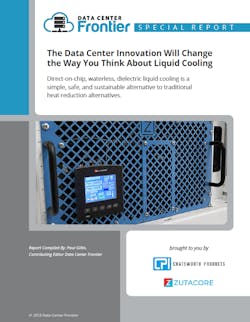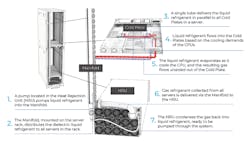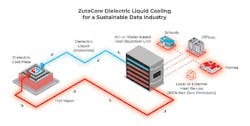Liquid Cooling: Going Beyond Water
We continue our article series on the latest innovations in liquid cooling technology. This week we'llgo beyond water and dive into dielectric fluid and direct-on-chip cooling.
Given the risks and drawbacks of water-based cooling inside racks and servers, the industry has been moving toward more-efficient chemical alternatives. One of the most promising of these is dielectric fluid, a non-conductive liquid with very high resistance to electrical breakdown, even at high voltages.
Unlike water, dielectric fluid can come in direct contact with electronic components without damaging them. Components can even be immersed in dielectric fluid without the risk of harm. This enables cooling to be applied more uniformly across a server or rack, reducing the risk of hot spots. The thermal conductivity and specific heat capacity of dielectric liquids are higher than that of air. That makes them more efficient at removing waste heat.
Engineered refrigerant dielectric fluids are designed to evaporate at much lower temperatures than water, allowing liquids to transform into vapor and then condense back into liquid form at temperatures that are much lower than the boiling point of water. Heat can be rapidly transferred away from the equipment, allowing for improved cooling performance and maintaining lower operating temperatures.
Dielectric fluids have been engineered to be chemically stable and resist degradation over time. Unlike water-based solutions, they do not require filtration or replacement over the life of the system.
Direct-on-chip-cooling
The most efficient use of dielectric liquids is in direct- on-chip, waterless, two-phase liquid cooling. This technique pumps fluid into cold plates directly over electronic components such as CPUs and GPUs in a closed-loop system. Super-heated vapor is pumped back into a heat rejection unit where it can be reused to heat the air and water in the data center facility.
Join us on Aug. 29th for a day of learning covering air-based cooling and direct-on-chip cooling technologies, and optimizing the data center cooling cycle. Register for the Data Center Frontier Cooling Educational Forum today.
The elegantly simple design requires just three subsystems: direct-on-chip cold plates, liquid/vapor manifolds, and heat-rejection units. Direct-on-chip solutions fit easily within a 1U rack-mounted server chassis and can be retrofitted onto existing equipment. The result is that data centers can realize triple the processing capacity at less than half the energy usage and space of conventional cooling systems.
A single 3U or 6U in-rack heat rejection unit can support up to 100 kilowatts of computing power per rack and cool processors running at up to 1,000 watts, giving data center operators a solution that will support their needs many years into the future.
The self-contained solution eliminates the risk of electrical short circuits while also protecting electronic components from airborne dust, vibration, and other byproducts of air conditioning. Delicate components last longer because heat levels are managed more consistently and overheating is never an issue.
The bottom line is that direct-on-chip, dielectric two-phase liquid cooling supports higher levels of computing power at half the total cost of ownership with up to 100% heat reuse and reduced emissions.
Download the full report, The Data Center Innovation Will Change the Way You Think About Liquid Cooling, featuring Chatsworth Products and Zutacore, to learn more. In our next article, we'll explain how you can prepare your data center for liquid cooling.





